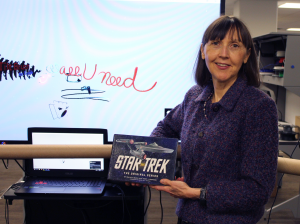By Heidi Brett, marketing and public relations director, J. Willard Marriott Library

There’s often talk about what libraries might look like in 2020. Although just three short years away, just hearing someone say 2020 brings up images of science fiction shows such as “Star Trek.” However, at the J. Willard Marriott Library, the “stuff” of science fiction doesn’t need to wait until 2020, it’s here now. The library has taken on the bold, new world of augmented and virtual reality and it clearly is a technology that has strong application across many fields.
Every Thursday from 2-3 p.m. on level two of the library, students can attend an open-door, drop-in augmented reality/virtual reality workshop. These sessions attract students and faculty from areas such as engineering, arts, medicine, computer science and the humanities.
Why is the library interested in this kind of technology?
“Scholars are still discovering how technology like virtual reality headsets can enable faculty and students to look at history in an entirely different way,” said Rebekah Cummings, research data management librarian. “For example, at Carnegie Mellon University, the NEH-funded Six Degrees of Francis Bacon project allows users to visualize complex social networks in the early modern world.”

The library is also developing new partnerships on campus. They are working with researchers and educators in rehabilitative medicine in the development of custom prosthetics. One application, currently in development, is using augmented reality technology and EEG sensors to connect a user with a robotic prosthetic.
Most exciting of all, this is just the beginning. There’s more to come as the library leads the way, “to go to where no one has gone before,” in teaching these technologies and assisting students, staff and faculty to apply the technology in their research, work and areas of study.
If you would like more information about the new technologies at the Marriott Library or a tour to see these technologies in action, please contact Heidi Brett at Heidi.brett@utah.edu.
